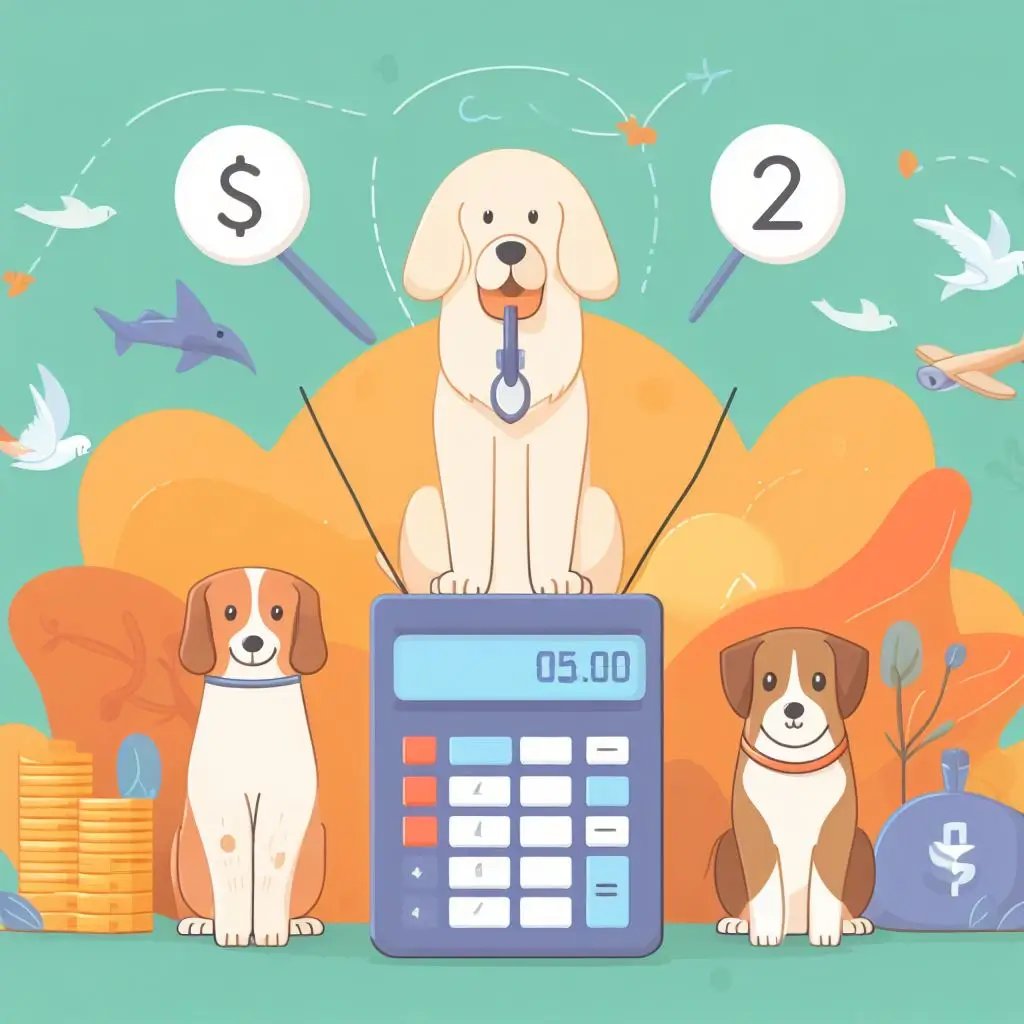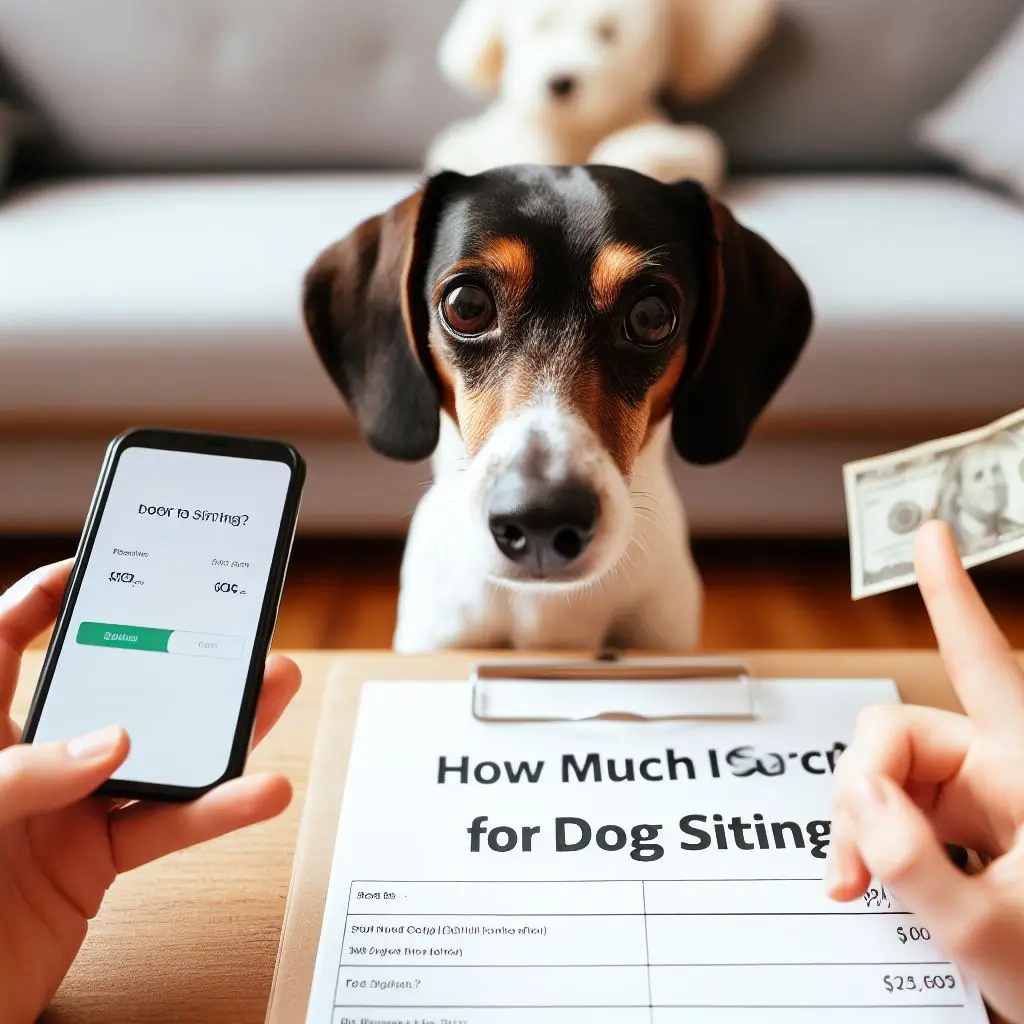Key Takeaway
| Question | Answer |
|---|---|
| What is the average cost of dog sitting? | According to [Care.com], the average cost of dog sitting in the US is $20 per visit or $40 per night. However, this may vary depending on factors such as location, experience, services, and demand. |
| How to set your dog sitting fees? | You can set your dog sitting fees by considering your expenses, time, skills, and value. You can also use online tools such as [Rover] or [PetBacker] to calculate your rates based on your location and services. |
| How to price your dog sitting services? | You can price your dog sitting services by using different strategies such as hourly, flat, tiered, or dynamic pricing. You can also offer discounts, packages, or add-ons to attract more clients and increase your income. |
Dog sitting rates: What to charge
Dog sitting is a service that involves taking care of a dog while the owner is away. Dog sitters may visit the dog’s home, stay overnight with the dog, or host the dog at their own place. Dog sitters may also provide additional services such as feeding, walking, playing, grooming, training, or administering medication to the dog.
Dog sitting rates vary depending on the type of service, the duration of the service, and the location of the service. According to [Care.com], the average cost of dog sitting in the US is $20 per visit or $40 per night. However, this may not reflect the actual rates in your area or for your specific service.

Here are some examples of different types of dog sitting services and their average rates in the US:
- Drop-in visits: This is when a dog sitter visits the dog’s home for a short period of time, usually 15 to 30 minutes, to check on the dog, feed them, and give them some attention. The average rate for this service is $16 per visit.
- Overnight stays: This is when a dog sitter stays with the dog at their home overnight, usually from 7 pm to 7 am, to provide companionship and care. The average rate for this service is $40 per night.
- House sitting: This is when a dog sitter stays with the dog at their home for an extended period of time, usually 24 hours or more, to provide full-time care and security. The average rate for this service is $50 per day.
- Boarding: This is when a dog sitter hosts the dog at their own place, either in a spare room or a kennel, to provide care and supervision. The average rate for this service is $35 per night.
These rates may vary depending on the duration of the service, as some dog sitters may offer discounts for longer stays or charge extra for shorter stays. For example, some dog sitters may charge $25 per night for stays longer than a week or $45 per night for stays shorter than two nights.
These rates may also vary depending on the location of the service, as some areas may have higher or lower demand and competition for dog sitting. For example, some dog sitters in New York City may charge $60 per night for overnight stays or $80 per day for house sitting, while some dog sitters in Omaha may charge $25 per night for overnight stays or $35 per day for house sitting.
As you can see, there is no one-size-fits-all answer to how much you should charge for dog sitting. You need to consider your own costs, time, skills, value, and pricing strategy when setting your rates. In the next sections, we will discuss how to determine and calculate your dog sitting fees in more detail.

What is the average cost of dog sitting?
Dog sitting is a popular and convenient option for pet owners who need someone to take care of their dogs while they are away. Dog sitters can provide various services such as drop-in visits, overnight stays, house sitting, or boarding, depending on the client’s needs and preferences.
But how much does dog sitting cost? According to [Care.com], the average cost of dog sitting in the US is $20 per visit or $40 per night. However, this is only a general estimate, and the actual cost may vary depending on several factors, such as:
- The region: The cost of dog sitting may differ by state, city, or neighborhood, depending on the supply and demand, the cost of living, and the competition in the area. For example, dog sitting in New York City may be more expensive than dog sitting in Omaha.
- The service: The cost of dog sitting may depend on the type and duration of the service that the client requests. For example, drop-in visits may be cheaper than overnight stays, and longer stays may be cheaper per night than shorter stays.
- The dog: The cost of dog sitting may also depend on the number, size, breed, temperament, and special needs of the dog that the client owns. For example, more or larger dogs may require more work and resources from the dog sitter, and some breeds or personalities may be more challenging or demanding than others.
- The sitter: The cost of dog sitting may also depend on the experience, skills, reputation, and availability of the dog sitter that the client hires. For example, more experienced or skilled dog sitters may charge more for their service, and more reputable or popular dog sitters may have higher demand and lower availability.
To give you a better idea of how much dog sitting costs in different regions and for different services, we have compiled some data from [Rover] and [PetBacker], two of the most popular online platforms for finding and booking dog sitters in the US. Here are some tables that show the average or range of dog sitting rates in some major cities in the US for different types of services:

Drop-in visits
| City | Average rate per visit | Range of rates per visit |
|---|---|---|
| New York | $21 | $15 – $30 |
| Los Angeles | $18 | $12 – $25 |
| Chicago | $17 | $12 – $23 |
| Houston | $16 | $11 – $22 |
| Phoenix | $15 | $10 – $20 |
Overnight stays
| City | Average rate per night | Range of rates per night |
|---|---|---|
| New York | $60 | $40 – $80 |
| Los Angeles | $45 | $30 – $60 |
| Chicago | $40 | $25 – $55 |
| Houston | $35 | $20 – $50 |
| Phoenix | $30 | $15 – $45 |
House sitting
| City | Average rate per day | Range of rates per day |
|---|---|---|
| New York | $80 | $50 – $110 |
| Los Angeles | $60 | $40 – $80 |
| Chicago | $50 | $30 – $70 |
| Houston | $45 | $25 – $65 |
| Phoenix | $40 | $20 – $60 |

Boarding
| City | Average rate per night | Range of rates per night |
|---|---|---|
| New York | $50 | $30 – $70 |
| Los Angeles | $40 | $25 – $55 |
| Chicago | $35 | $20 – $50 |
| Houston | $30 | $15 – $45 |
| Phoenix | $25 | $10 – $40 |
As you can see, there is a wide variation in dog sitting rates across different regions and services. Therefore, it is important to do your research and compare your options before hiring a dog sitter or setting your own rates as a dog sitter. In the next section, we will discuss how to understand the economics of dog sitting and how it affects your income and profitability.
Determining the cost of dog sitting
Before you set your dog sitting fees, you need to determine how much it costs you to provide your service. This will help you ensure that you are covering your expenses and making a profit. There are two types of costs that you need to consider: fixed costs and variable costs.
Fixed costs are the costs that do not change regardless of how many dogs you sit or how long you sit them. These include:
- Transportation: the cost of gas, parking, tolls, or public transit to get to and from the dog’s home or your place.
- Food: the cost of feeding yourself and the dog, if you are responsible for providing their food.
- Supplies: the cost of buying or maintaining any equipment or materials that you need for dog sitting, such as leashes, collars, toys, bowls, beds, crates, etc.
- Insurance: the cost of protecting yourself and the dog from any accidents, injuries, or damages that may occur during your service. You may need to purchase a pet sitter insurance policy or a general liability insurance policy to cover your risks.
- Taxes: the cost of paying taxes on your income from dog sitting. You may need to register as a self-employed or independent contractor and file your taxes accordingly.
- Marketing: the cost of promoting your service and attracting new clients. This may include creating a website, a social media account, a business card, a flyer, etc.
Variable costs are the costs that change depending on how many dogs you sit or how long you sit them. These include:
- Time: the cost of spending your time with the dog instead of doing other activities. You need to consider how much your time is worth and how much you could earn from other sources.
- Skills: the cost of acquiring or improving your skills in dog care. You may need to invest in training, certification, or education to provide a better service or to specialize in a certain area.
- Value: the cost of delivering a high-quality service that meets or exceeds the expectations of your clients. You may need to invest in enhancing your reputation, building trust, and providing satisfaction.
To determine your total cost of dog sitting, you need to add up all your fixed and variable costs for each service that you offer. For example, if you offer drop-in visits for $16 per visit, and your fixed costs are $10 per day and your variable costs are $5 per hour, then your total cost for one visit is:
$10 + ($5 x 0.5) = $12.5
This means that you are making a profit of $3.5 per visit. However, if you offer overnight stays for $40 per night, and your fixed costs are $10 per day and your variable costs are $5 per hour, then your total cost for one night is:
$10 + ($5 x 12) = $70
This means that you are losing money by $30 per night. Therefore, you need to adjust your rates accordingly to make sure that you are not losing money or leaving money on the table.
In the next section, we will discuss how to set your dog sitting fees based on your costs and other factors.
How to set your dog sitting fees
Once you have determined your cost of dog sitting, you can set your dog sitting fees based on your cost and other factors. Your dog sitting fees should reflect the value that you provide to your clients and the market demand for your service. Here are some steps to help you set your dog sitting fees:
- Step 1: Calculate your break-even point. This is the minimum amount that you need to charge to cover your costs and make zero profit. You can use this formula to calculate your break-even point:
Break-even point = Fixed costs / (1 – Variable costs / Revenue)
For example, if your fixed costs are $10 per day and your variable costs are $5 per hour, and you offer overnight stays for 12 hours, then your break-even point is:
Break-even point = $10 / (1 – $5 x 12 / Revenue)
Solving for Revenue, you get:
Revenue = $10 / (1 – $60 / Revenue)
Multiplying both sides by (1 – $60 / Revenue), you get:
Revenue – $60 = $10
Adding $60 to both sides, you get:
Revenue = $70
This means that you need to charge at least $70 per night to break even.
- Step 2: Add your desired profit margin. This is the percentage of your revenue that you want to keep as profit. You can use this formula to calculate your desired profit margin:
Profit margin = Profit / Revenue x 100%
For example, if you want to make a profit of $10 per night, and your revenue is $70 per night, then your profit margin is:
Profit margin = $10 / $70 x 100% = 14.29%
This means that you want to keep 14.29% of your revenue as profit.
- Step 3: Calculate your final price. This is the amount that you will charge to your clients for your service. You can use this formula to calculate your final price:
Final price = Revenue / (1 – Profit margin)
For example, if your revenue is $70 per night and your profit margin is 14.29%, then your final price is:
Final price = $70 / (1 – 0.1429) = $81.67
This means that you will charge $81.67 per night for overnight stays.
You can use these formulas to calculate your fees for any type of service that you offer, such as drop-in visits, house sitting, or boarding. You can also use online tools such as [Rover] or [PetBacker] to help you calculate your rates based on your location and services.
However, these formulas are not the only way to set your fees. You may also want to consider other factors such as the market demand, the competition, the quality, and the value of your service. In the next section, we will discuss some pricing strategies that you can use to price your service more effectively.
Pricing strategies for dog sitters
Once you have set your dog sitting fees based on your costs and desired profit margin, you can use different pricing strategies to adjust your fees according to the market conditions and your business goals. Here are some common pricing strategies that dog sitters can use:
- Hourly pricing: This is when you charge by the hour for each visit or stay. This strategy is simple and transparent, and it allows you to adjust your fees based on the duration of the service. However, this strategy may not reflect the value of your service, and it may discourage clients from booking longer stays or multiple visits.
- Flat pricing: This is when you charge a fixed amount for each visit or stay regardless of the duration. This strategy is easy and convenient, and it encourages clients to book longer stays or multiple visits. However, this strategy may not cover your costs or time, and it may attract clients who are looking for the cheapest option.
- Tiered pricing: This is when you charge different rates for different levels of service or care. For example, you can charge more for premium services such as grooming, training, or special needs care, or less for basic services such as feeding, walking, or playing. This strategy allows you to differentiate your service and cater to different client needs and preferences. However, this strategy may complicate your pricing structure and confuse your clients.
- Dynamic pricing: This is when you adjust your rates based on supply and demand, seasonality, or special occasions. For example, you can charge more during peak periods such as holidays, weekends, or summer, or less during off-peak periods such as weekdays, winter, or rainy days. This strategy allows you to optimize your revenue and occupancy rate. However, this strategy may require constant monitoring and updating of your rates, and it may alienate your loyal or repeat clients.
You can use one or a combination of these pricing strategies to price your dog sitting services more effectively. You can also experiment with different rates and see how they affect your bookings and income. You can also use online tools such as [Rover] or [PetBacker] to compare your rates with other dog sitters in your area and see what works best for you.
In the next section, we will discuss some factors that can influence your dog sitting prices and how to handle them.
Factors influencing dog sitting prices
Besides your costs, time, skills, and value, there are other factors that can influence your dog sitting prices and how you charge them. These include:
- The number and size of dogs: More or larger dogs may require more work and resources from you, such as more food, water, space, attention, or cleaning. You may want to charge more for multiple or large dogs to compensate for your extra effort and expense. For example, you can charge an additional $5 to $10 per night for each additional or large dog.
- The breed and temperament of dogs: Some breeds or personalities may be more challenging or demanding than others, such as those that are aggressive, anxious, energetic, or noisy. You may want to charge more for these dogs to account for the potential risks or difficulties that they may pose. For example, you can charge an extra $10 to $20 per night for dogs that require special handling or care.
- The special needs of dogs: Some dogs may have medical conditions, dietary restrictions, behavioral issues, or other special needs that require more attention or expertise from you. You may want to charge more for these dogs to cover your additional costs or skills. For example, you can charge an extra $15 to $30 per night for dogs that need medication, injections, supplements, or special food.
- The additional services or requests: Some clients may ask you to provide additional services or requests that are not included in your standard service, such as grooming, training, walking, playing, or taking the dog to the vet. You may want to charge extra for these services or requests to increase your income and value. For example, you can charge an additional $10 to $50 per service or request depending on the type and duration.
You can handle these factors by either adding them to your base rate or offering them as add-ons or extras. You can also communicate them clearly to your clients and explain why you charge them. You can also use online tools such as [Rover] or [PetBacker] to see how other dog sitters handle these factors and what they charge for them.
In the next section, we will discuss how to compare your dog sitting rates with other dog sitters in your area and why it is important.
Comparing dog sitting rates in your area
One of the best ways to set your dog sitting fees is to compare them with other dog sitters in your area. This will help you understand the market demand, the competition, and the price range for your service. You can use different sources and methods to find out the average or range of dog sitting rates in your area, such as:
- Online platforms: You can use online platforms such as [Rover] or [PetBacker] to see what other dog sitters are charging for their services in your location. You can filter by service type, duration, number of dogs, and other criteria to get a more accurate comparison. You can also read the reviews and ratings of other dog sitters to see what their clients think of their service and value.
- Local directories: You can use local directories such as [Yellow Pages], [Yelp], or [Google My Business] to find and contact other dog sitters in your area. You can ask them about their rates, services, and availability, and see how they present themselves and their business. You can also check their online presence and reputation to see how they market their service and attract new clients.
- Word-of-mouth: You can ask other dog sitters, pet owners, veterinarians, groomers, trainers, or anyone who is involved in the pet industry in your area about the dog sitting rates and services. You can get honest feedback and recommendations from them, and learn from their experiences and insights. You can also network with them and build relationships that may benefit your business.
By comparing your dog sitting rates with other dog sitters in your area, you can get a better idea of how to price your service competitively and realistically. However, you should not base your rates solely on what others are charging. You should also consider your own unique value proposition and competitive advantage when setting your rates. In the next section, we will provide some tips and best practices for pricing your dog sitting services.
Tips for pricing your dog sitting services
Pricing your dog sitting services can be challenging and confusing, especially if you are new to the business or the market. However, with some research, planning, and experimentation, you can find the best rates that suit your service and your clients. Here are some tips and best practices for pricing your dog sitting services:
- Be transparent and consistent: Communicate your rates clearly and stick to them unless there are valid reasons to change them. Avoid hidden fees, surprise charges, or last-minute changes that may annoy or disappoint your clients. Explain your rates and what they include, and provide receipts or invoices for your service.
- Be flexible and negotiable: Be willing to adjust your rates based on the client’s needs, budget, or preferences, but don’t undersell yourself or compromise your quality. Offer discounts, packages, or add-ons to attract more clients and increase your income. However, don’t lower your rates too much or too often that may devalue your service or hurt your reputation.
- Be fair and reasonable: Charge what you think is fair for your service and what the market can bear, but don’t overcharge or undercharge your clients. Consider your costs, time, skills, value, and pricing strategy when setting your rates. Also, consider the client’s expectations, satisfaction, and loyalty when charging them.
- Be professional and confident: Present your rates with confidence and professionalism, and justify them with your credentials, testimonials, or portfolio. Don’t apologize or feel guilty for charging what you deserve. Don’t let the client pressure or intimidate you into lowering your rates. Stand by your rates and deliver a great service that matches them.
By following these tips and best practices, you can price your dog sitting services more effectively and efficiently. You can also use online tools such as [Rover] or [PetBacker] to help you set and manage your rates easily. Remember that pricing is not a one-time decision, but an ongoing process that requires constant evaluation and improvement.
In the next section, we will provide a summary of the average cost of dog sitting in the US and how it varies by region, service, and duration.
Calculating your dog sitting service fees
In the previous sections, we have discussed how to determine your cost of dog sitting, how to set your dog sitting fees, how to price your dog sitting services, how to handle the factors influencing your dog sitting prices, how to compare your dog sitting rates with other dog sitters in your area, and how to understand the economics of dog sitting. In this section, we will provide a step-by-step guide on how to calculate your dog sitting service fees based on your costs and other factors.
Here are the steps to calculate your dog sitting service fees:
- Step 1: Choose the type of service that you want to offer, such as drop-in visits, overnight stays, house sitting, or boarding. You can offer one or more types of service depending on your availability, preference, and demand.
- Step 2: Calculate your fixed costs for each type of service that you offer. These are the costs that do not change regardless of how many bookings you get, such as transportation, food, supplies, insurance, taxes, and marketing. You can use this formula to calculate your fixed costs:
Fixed costs = Sum of all fixed expenses per day
For example, if you spend $5 on gas, $10 on food, $15 on supplies, $20 on insurance, $25 on taxes, and $10 on marketing per day, then your fixed costs are:
Fixed costs = $5 + $10 + $15 + $20 + $25 + $10 = $85
- Step 3: Calculate your variable costs for each type of service that you offer. These are the costs that change depending on how many bookings you get, such as time, skills, and value. You can use this formula to calculate your variable costs:
Variable costs = Hourly rate x Hours per booking
For example, if you charge $10 per hour for your time, skills, and value, and you spend 0.5 hours for drop-in visits, 12 hours for overnight stays, 24 hours for house sitting, or 8 hours for boarding per booking, then your variable costs are:
Variable costs for drop-in visits = $10 x 0.5 = $5 Variable costs for overnight stays = $10 x 12 = $120 Variable costs for house sitting = $10 x 24 = $240 Variable costs for boarding = $10 x 8 = $80
- Step 4: Calculate your total cost for each type of service that you offer. This is the sum of your fixed and variable costs for each booking. You can use this formula to calculate your total cost:
Total cost = Fixed costs + Variable costs
For example, if your fixed costs are $85 and your variable costs are $5 for drop-in visits, $120 for overnight stays, $240 for house sitting, or $80 for boarding per booking, then your total cost is:
Total cost for drop-in visits = $85 + $5 = $90 Total cost for overnight stays = $85 + $120 = $205 Total cost for house sitting = $85 + $240 = $325 Total cost for boarding = $85 + $80 = $165
- Step 5: Calculate your break-even point for each type of service that you offer. This is the minimum amount that you need to charge to cover your costs and make zero profit. You can use this formula to calculate your break-even point:
Break-even point = Total cost
For example, if your total cost is $90 for drop-in visits, $205 for overnight stays, $325 for house sitting, or $165 for boarding per booking, then your break-even point is:
Break-even point for drop-in visits = $90 Break-even point for overnight stays = $205 Break-even point for house sitting = $325 Break-even point for boarding = $165
- Step 6: Add your desired profit margin for each type of service that you offer. This is the percentage of your revenue that you want to keep as profit. You can use this formula to calculate your desired profit margin:
Profit margin = Profit / Revenue x 100%
For example, if you want to make a profit of 20% of your revenue for each type of service that you offer, then your profit margin is:
Profit margin = 20%
- Step 7: Calculate your final price for each type of service that you offer. This is the amount that you will charge to your clients for each booking. You can use this formula to calculate your final price:
Final price = Total cost / (1 – Profit margin)
For example, if your total cost is $90 for drop-in visits, $205 for overnight stays, $325 for house sitting, or $165 for boarding per booking, and your profit margin is 20%, then your final price is:
Final price for drop-in visits = $90 / (1 – 0.2) = $112.5 Final price for overnight stays = $205 / (1 – 0.2) = $256.25 Final price for house sitting = $325 / (1 – 0.2) = $406.25 Final price for boarding = $165 / (1 – 0.2) = $206.25
These are the prices that you will charge for each type of service that you offer based on your costs and desired profit margin. You can also use online tools such as [Rover] or [PetBacker] to help you calculate your rates based on your location and services.
However, these prices are not the only way to charge for your service. You may also want to consider other factors such as the market demand, the competition, the quality, and the value of your service. You may also want to use different pricing strategies such as hourly, flat, tiered, or dynamic pricing to adjust your prices according to the market conditions and your business goals.
By following these steps and using these formulas, you can calculate your dog sitting service fees more accurately and effectively. You can also experiment with different prices and see how they affect your bookings and income. You can also use online tools such as [Rover] or [PetBacker] to compare your prices with other dog sitters in your area and see what works best for you.
We hope that this guide has helped you understand how to calculate your dog sitting service fees and how to price your dog sitting services more effectively and efficiently. We wish you all the best in your dog sitting business and we hope that you enjoy providing a great service to your furry friends and their owners.
Hi, I’m John and I love dogs. Ever since I was a kid, I always wanted to have a furry friend by my side. I grew up with a golden retriever named Max, who taught me a lot about loyalty, friendship, and fun. He was my best buddy for 12 years, and I miss him every day.
